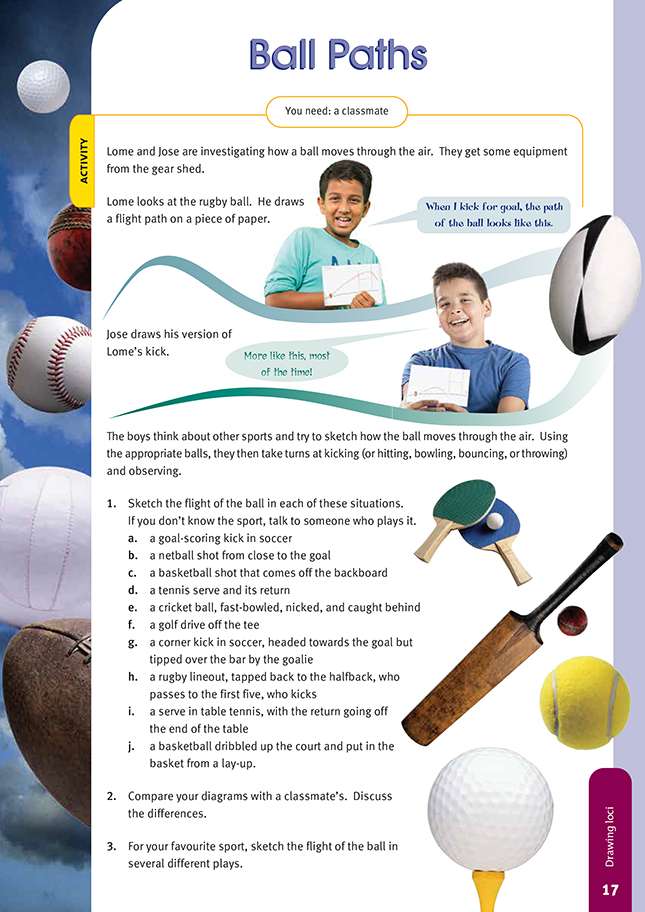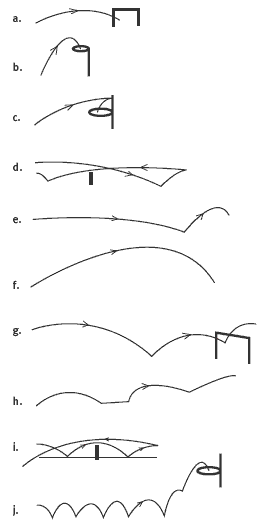This is a level 4 geometry strand activity from the Figure It Out series.
A PDF of the student activity is included.
Click on the image to enlarge it. Click again to close. Download PDF (257 KB)
draw loci
FIO, Level 4, Geometry, Book One, Ball Paths, page 17
classmate
Many students are keen sportspeople. This activity taps that interest and experience, tying it to the geometrical concept of locus, the path traced by a moving object. A level 4 suggested learning experience is "Students should be drawing loci (the paths of objects moving in space) including the flight path of balls, the locus of points which are a fixed distance from a given point (circle), a given straight line (a parallel line), and a circle (a concentric circle)."
Some students have trouble with the concept of locus, but you can refer them to familiar examples that will help explain it:
- the mark on the floor where a heavy object has been dragged across it
- the mark on the road where a car has skidded
- the path traced through the snow by a skier
- the patterns made by a child when doing a finger-painting
- the vapour trail that a jet plane has made through the sky
- the footprints left in the sand by a person walking along the beach.
- In each of these examples, the movement of an object or a person leaves a visible path that can be followed.
A ball moving through the air doesn't leave a record, but it still has a locus.
Your class probably has "experts" in a number of the sports featured in question 1, and they may be happy to talk to their classmates about how the ball moves in typical plays. They will need to show what they mean, using diagrams on the whiteboard. If you are not a sportsperson yourself, you may have a knowledgeable colleague who is willing to come into your class and contribute to the discussion.
In most of the situations listed, a person applies force to the ball, sending it up or along until gravity brings it back to earth. In the case of the tennis serve and the fast-bowled cricket ball, the sportsperson generally applies force in a downwards direction.
Sportspeople practise long hours to discover the best way to impart force to the ball, taking into account gravity and wind conditions. The degree of judgment involved in getting the ideal locus for the ball is amazing.
The slightest deviation at the point of last human contact with the ball can make it fall short, go too far, or go wide of its mark. You could have a lively discussion about this with your students.
You could also consider in more detail what happens when a ball comes into contact with the ground, the backboard in basketball, or the cushion on a pool table. Those who play sports probably understand intuitively that the angle at which the ball strikes and leaves the ground (or backboard or cushion) is the same. This fact can be illustrated in a simple diagram:
Of course, this only works if the ground is reasonably hard and smooth. A golf ball landing in sand displays somewhat different behaviour. Spin also has an effect on the angle. What about a rugby ball? Well, that is something different again!
Question 3 gives students a chance to consider sports that donÕt appear in question 1, such as volleyball and badminton.
Possible extension activities include:
- investigating the movement of a ball as it bounces successively off the cushion on different sides of a pool table
- finding a way of measuring the bounce of different balls when they hit a hard surface
- finding the angle of elevation that will give the greatest distance for a ball launched with constant force.
This could be done with a cardboard tube, table tennis ball, and rubber band and could be a very good technology and mathematics project.
Answers to Activity
1. The drawings for a-j will be similar to the ones below. They may also show the ball bouncing after it lands.
2. Discussion will vary.
3. Practical activity


